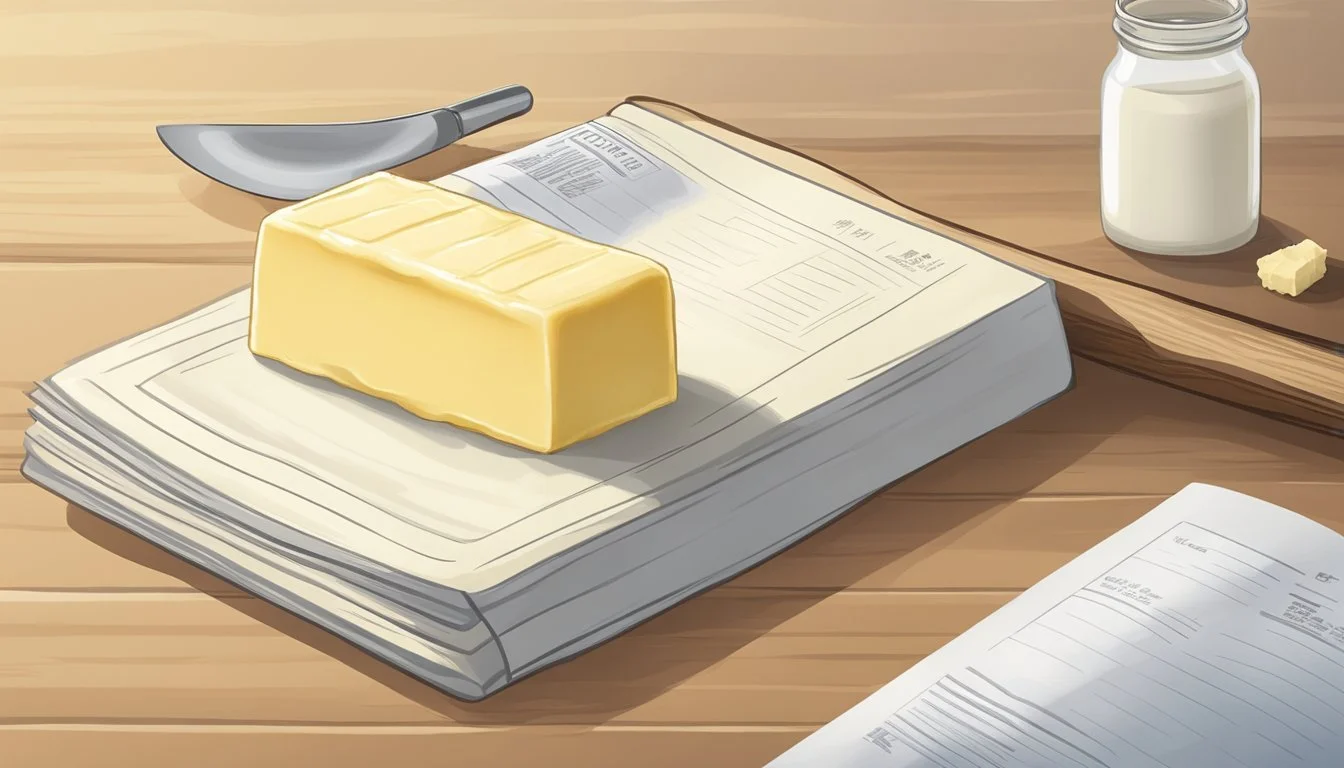How Long Does Challenge Unsalted Butter Last?
Shelf Life Explained
Unsalted butter (how long does butter last?), a staple in many kitchens, has a finite shelf life. The absence of salt slightly reduces the preservation quality, meaning that unsalted butter, including a brand like Challenge, will not last as long as its salted counterpart. Challenge unsalted butter, when stored in the refrigerator, typically remains fresh for about four to five months. To extend its shelf life, proper storage is crucial. It is recommended to keep unsalted butter well-wrapped to protect it from absorbing odors and to prevent the fats from breaking down due to exposure to light and air.
For those who do not plan to use their Challenge unsalted butter within a few months, freezing offers a viable solution. Freezing can preserve the freshness of the butter for up to a year. When freezing butter, it should be sealed in its original packaging or placed in a heavy-duty freezer bag to maintain quality. Thawing should then be done in the refrigerator, and for the best taste and texture, it should be used within a month after thawing. Hence, whether used frequently for cooking or baking, or stored for sporadic use, Challenge unsalted butter's shelf life can accommodate various consumer needs with appropriate storage practices.
Understanding Butter
Butter is a staple in many kitchens, and it comes in various types, each with a distinct characteristic that caters to different cooking needs. Primarily, butter is made from the fat and protein components of milk, usually from cows. Butter can be categorized into two primary types: salted and unsalted.
Salted butter has salt added to it, which acts not only as a flavor enhancer but also as a preservative, extending its shelf life. In contrast, unsalted butter lacks this addition. As a result, unsalted butter offers a purer buttery flavor, making it a preferred choice for many baking recipes where the precise control of salt content is essential.
The fat content in butter usually hovers around 80%, providing richness to dishes. However, fat is also vulnerable to spoilage, and thus, proper storage is key to maintain butter's quality.
Storage Lifespan:
Refrigerated: 4 to 5 months
Frozen: Up to 1 year
Given its fat and dairy content, unsalted butter, like other dairy products, has a finite shelf life. It's crucial to store it in conditions that mitigate the degradation of fat particles.
Lastly, unsalted butter should be well-wrapped and refrigerated to ensure freshness. If freezing, it's advisable to store in wrapped portions for easy use, without having to defrost the entire block.
Shelf Life Fundamentals
Understanding the shelf life of unsalted Challenge butter is essential for both culinary quality and food safety. This section breaks down what shelf life means, the factors influencing it, and differences in preservation between salted and unsalted butter.
Defining 'Shelf Life'
Shelf Life refers to the period during which butter remains safe to consume and retains its desired sensory qualities, such as taste and texture. After this period, butter may experience rancidity or spoilage due to various elements affecting its composition.
Factors Affecting Butter's Shelf Life
Several determinants play a crucial role in the shelf life of butter:
Temperature: Butter should be stored below 40ºF to prevent spoilage, with the freezer providing an extended shelf life of up to 12 months.
Light and Oxygen: Exposure to light and oxygen can accelerate rancidity, making proper wrapping essential.
Bacteria: Lower temperatures inhibit bacterial growth, which is pivotal in preserving butter's shelf life.
Salted vs Unsalted Butter Shelf Life
Salt acts as a preservative by drawing water out of bacteria, thus inhibiting their growth. Therefore, salted butter enjoys an enhanced shelf life compared to unsalted butter, typically by about 30 days when refrigerated. Unsalted butter, devoid of this natural preservative, usually lasts one to three months in the fridge and up to six to nine months in the freezer.
Storing Unsalted Butter
Proper storage of unsalted butter is crucial for maintaining its quality and freshness. Whether it's in the refrigerator, freezer, or on the countertop, each method requires specific conditions to ensure the butter remains safe for consumption and retains its intended consistency.
Refrigeration Guidelines
Unsalted butter should be stored in the refrigerator at a temperature of around 32°F to 38°F. To maintain the quality of refrigerated butter, it should be kept:
Covered: Place the unsalted butter in a butter keeper or wrap it in its original packaging to protect it from strong odors.
Sealed: Use an airtight container if the original packaging is no longer intact to prevent the absorption of flavors and moisture.
Freezer Storage
For long-term storage, unsalted butter can be frozen. Follow these tips to extend the shelf life of frozen butter:
Packing: Wrap the butter in aluminum foil or plastic wrap before placing it in an airtight container or heavy-duty freezer bag.
Duration: Properly stored, unsalted butter can last in the freezer for up to 12 months without significant quality loss.
Thawing: Move the butter to the refrigerator to thaw gradually. Do not thaw at room temperature to prevent bacterial growth.
Countertop and Butter Dish
Keeping unsalted butter on the countertop provides easy access and a spreadable consistency but is not recommended for prolonged periods due to the risk of spoilage:
Short-Term: Leave unsalted butter at room temperature only for the time needed to soften, which is typically 30 to 60 minutes.
Environment: Use a butter dish with a lid to shield the butter from contaminants and to maintain some degree of temperature control.
Identifying Spoiled Butter
When it comes to distinguishing fresh from spoiled butter, there are definitive signs to look for in terms of visual changes and smell which are telltale indicators of spoilage.
Visual and Textural Clues
One can determine the state of butter by examining its visual and textural aspects. Fresh butter should maintain a uniform color and firm texture. In the case of spoiled butter, the visual signs to watch for include:
Discoloration: If the butter shows any signs of yellowing or darkening compared to its usual creamy color, it suggests a deviation from freshness.
Texture: A change in texture, such as a mushy quality or excess oiliness, may indicate the butter has gone rancid.
Mold Growth: White, green, or black spots are clear signs of mold, which can occur with bacterial contamination, especially if the butter has been exposed to moisture or is past its expiration date.
Olfactory Indications
The smell of butter is a reliable indicator of its condition. Healthy, fresh butter will have a clean, creamy scent. Spoiled butter, on the other hand, will exhibit:
Off-flavor: A sour or otherwise unpleasant taste can suggest butter is no longer suitable for consumption.
Rancid smell: An intense or foul odor is a strong sign that the butter has become rancid and should not be used.
If one detects any of these olfactory changes, it is wise not to consume the product to avoid potential health risks associated with expired butter.
Practical Usage of Unsalted Butter
Unsalted butter plays a versatile role in culinary arts, prized for its ability to carry and enhance flavors without the additional salt found in its salted counterpart. It affords cooks control over the seasoning in their dishes and offers optimal flexibility for baking and cooking purposes.
Culinary Applications
Unsalted butter finds its place in a variety of cooking contexts. In baking, its absence of salt allows bakers to precisely manage the flavor profile of cookies, cakes, and pastries. When a recipe calls for unsalted butter, it often aims to achieve a certain balance and purity of taste; salt, if needed, is added separately. Additionally, unsalted butter is ideal for sauces and sautéing, enhancing the dish with a creamy texture without altering the intended flavor balance.
Baking: Ensures that the sweetness of baked goods is not compromised.
Cooking: Enables flavor control, especially important in delicate sauces.
Sautéing: Heats without burning as quickly as margarine or oils.
Spreading: Offers a pure, sweet cream flavor perfect for spreading on breads and muffins.
Softening for Use
Properly softening unsalted butter is critical for its performance in recipes, especially in baking. Ideally, unsalted butter should be softened to room temperature to ensure even mixing without melting; the goal is not to let it liquefy but to make it pliable. A softened state contributes to the proper aeration of batters and doughs, providing the creamy texture critical to the structure of baked goods.
Before Baking: Remove from refrigeration 30 to 60 minutes before use.
Quick Softening: Cut the butter into small pieces to speed up the softening process.
Avoid Heat: Do not soften unsalted butter using direct heat sources.
When storing unsalted butter, it should be kept in the refrigerator away from strong-smelling foods to avoid absorption of unwanted odors. For long-term storage, unsalted butter may be frozen, extending its shelf life while maintaining quality. Whether one chooses to cook, bake, or simply spread their unsalted butter, it should always be handled with care to preserve its quality and flavor.
Best Practices for Butter Longevity
Maintaining the freshness and extending the shelf life of unsalted butter revolves around proper storage, understanding expiration labels, and preventing flavor contamination. Adhering to specific storage guidelines and interpreting labels correctly ensures both freshness and food safety.
Optimal Storage Conditions
Unsalted butter remains fresh when stored between 32°F and 38°F, typically in the refrigerator. Storage should ideally be:
In the Refrigerator: Wrap the butter in its original packaging or place it in an airtight container to shield it from odors and prevent dryness. A covered container also keeps the butter away from direct light.
In the Freezer: For extended longevity, unsalted butter can be frozen for up to one year. It should be tightly wrapped in aluminum foil or plastic wrap and placed inside a freezer bag or airtight container.
Understanding Expiration Labels
Butter packaging is marked with dates such as “best by,” use by, or “best if used by” which indicate:
“Best By” Date: The peak quality of the butter as determined by the manufacturer. Unsalted butter can be used beyond this date if stored properly, but it’s best to assess freshness periodically.
Expiration Date: This label implies that the butter should not be consumed beyond the printed date. It's critical to adhere to this date for optimal food safety.
Preventing Flavor Contamination
Unsalted butter absorbs flavors, so keeping it away from strong-smelling foods is essential. Best practices include:
Use Airtight Containers: An airtight container or at least tightly wrapped packaging minimizes exposure to pungent odors.
Keep Away From Heat Sources: Store butter away from the stove or other heat sources to prevent premature melting or spoilage.
By meticulously managing storage conditions, comprehending expiration labels, and guarding against flavor contamination, unsalted butter can remain fresh and full of its natural, sweet cream flavor for an extended period.
Alternatives to Unsalted Butter
When a recipe calls for unsalted butter and you don't have it on hand or seek a different option due to dietary restrictions or flavor preferences, several alternatives can be utilized.
Using Salted Butter
If salted butter is available, it can replace unsalted butter by reducing or eliminating any additional salt the recipe calls for. The typical conversion is:
For every half cup of salted butter used, subtract 1/4 teaspoon of salt from the recipe.
It's crucial to adjust seasoning to taste, especially in recipes where butter is a key ingredient.
Butter Substitutes
Beyond traditional butter, there are multiple substitutes that can be used based on the desired outcome:
Margarine: A plant-based alternative that approximates the flavor and texture of butter; suitable for vegans and those avoiding dairy.
Substitute Features Margarine Dairy-free, similar consistency, variable fat content
Ghee: Clarified butter with a nuttier flavor, ideal for high-heat cooking and adding depth to dishes.
Substitute Features Ghee No dairy solids, high smoke point
Yogurt: Especially in baking, plain yogurt can impart tenderness and a subtle tanginess.
Substitute Usage Note Yogurt Replace in baking with care for moisture content Strain to thicken if necessary
To properly store butter or its substitutes, keep them refrigerated, and for longer-term storage, they can be frozen. When substituting, one should always be mindful of the moisture and fat content to maintain the integrity of the original recipe.
Regulatory and Health Aspects
When addressing the longevity and safety of unsalted butter, such as Challenge Unsalted Butter, it is crucial to consider both regulatory standards and health implications. Regulatory agencies, like the U.S. Food and Drug Administration (FDA), establish guidelines that ensure food safety and are a benchmark for manufacturers and consumers alike.
Storage Recommendations:
Refrigeration: Unsalted butter should be kept refrigerated at 40°F (4°C) or below to thwart bacterial growth. Typically, it lasts one to three months under these conditions.
Freezing: For extended storage, unsalted butter can be frozen for up to 12 months without significant quality loss.
Summer Considerations:
Heat Sensitivity: Unsalted butter is more prone to spoilage in summer due to higher temperatures. It requires strict adherence to recommended storage temperatures to prevent the proliferation of foodborne pathogens.
Food Safety: Consumers should be vigilant during hot months and minimize unsalted butter's exposure to heat.
Health Factors:
Spoilage Signs: Indicators such as an off smell, discoloration, or mold should be heeded as signs of spoilage.
Nutrient Preservation: Proper storage preserves not only the butter’s safety but also its nutritional integrity.
Each consumer is responsible for following these guidelines to maintain the butter's freshness and ensure its safety for consumption. While regulatory bodies set forth the standards for food safety, consumers play a pivotal role in adhering to these regulations to protect their health.









